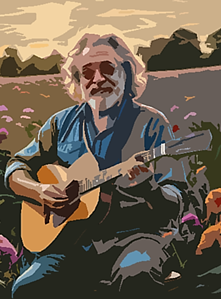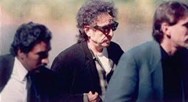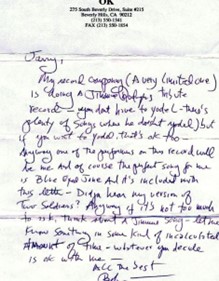My Rough And Rowdy Ways
by Jochen Markhorst
I But if you want to yodel, that’s ok too
 Even Dylan’s False Prophet, who 25 years later would proclaim himself “I’m first among equals, second to none,” apparently still ranks a notch below Jerry Garcia, frontman of the legendary band Grateful Dead. “He really had no equal,” Dylan writes on 10 August 1995 in his requiem for his friend, for Captain Trips, for the Supreme Deadhead, for the undisputed king of Haight-Ashbury who died the day before, shortly after his 53rd birthday, Jerome John Garcia.
Even Dylan’s False Prophet, who 25 years later would proclaim himself “I’m first among equals, second to none,” apparently still ranks a notch below Jerry Garcia, frontman of the legendary band Grateful Dead. “He really had no equal,” Dylan writes on 10 August 1995 in his requiem for his friend, for Captain Trips, for the Supreme Deadhead, for the undisputed king of Haight-Ashbury who died the day before, shortly after his 53rd birthday, Jerome John Garcia.
The bond goes deeper than collegial admiration. It is an apocryphal but persistent story that Dylan applied for a job as a band member in the late 1980s, but was rejected due to a veto by bassist Phil Lesh. However, in his autobiography Searching for the Sound (2005), Lesh makes no mention of any application – insinuating quite the contrary, in fact. His boundless admiration for Dylan flares up more than ten times, and the 1987 Dylan & The Dead tour is a personal highlight: “We had always wanted to play behind him like The Band did in the sixties. We were very pleased to find out that Bob was agreeable.” Phil’s memories and anecdotes echo the experiences we have heard dozens of times from others:
“Bob gave us a set list each show before we went on stage. Lotsa luck. At least twice Bob, that prankster, threw in a song we hadn’t rehearsed. Playing with Bob really kept us on our toes, too; he was fully capable of deviating radically from the set list, and more than once left us slack-jawed in confusion as he switched songs in midstream. That seemed like poetic justice for a band that took pride in its flexibility and in not using a set list.”
Phil thinks it’s great: “Hey, this guy’s at least as weird as any of us.” Co-frontman Bob Weir, on the other hand, is much less positive in his conversations with Howard Sounes (for his book Down The Highway, 2001):
“It’s as if we had never practised,” says Weir. “[Bob] came up with a set list [that] didn’t have much to do with what we had rehearsed.” Bob played in the wrong key and seemed to forget his own lyrics.
Alcohol in sad quantities and alarming regularity, Weir suggests. He then reveals that Dylan did indeed apply for the job in 1989, two years after that joint tour. “I was in for that, but one of our members didn’t particularly care for him,” he claims there – and 45 pages later, Sounes reveals the name: Phil Lesh was the dissenting voice, “according to Bob Weir”. Not very credible; Phil’s love for Dylan seems deep and sincere, judging by the many declarations of love in his memoirs and, even more so, by the joint concerts in the autumn of 1999 and the summer of 2000, the double bill Bob Dylan and his band / Phil Lesh and Friends, the tour during which they played together dozens of times and offered exceptional performances of both Dead songs (“Friend of the Devil”) and Dylan classics (“Blowin’ In The Wind”, “Rainy Day Women”).
The men demonstrate mutual admiration and a joy in playing that makes Weir’s claim that Lesh “didn’t particularly care for him” sound unconvincing. A mutual admiration that Dylan immortalises in The Philosophy Of Modern Song, in chapter 29, “Truckin’”: “Lesh is one of the most skilled bassists you’ll ever hear in subtlety and invention.”
Anyway, Jerry Garcia. His death affected Dylan deeply, as evidenced not only by that requiem. Dylan usually avoids funerals of beloved and admired colleagues, even comrades-in-arms such as Robbie Robertson, Pete Seeger or George Harrison – either because he is far away on tour or because he knows that his presence will only distract attention from the ceremony – but he does attend Jerry’s funeral to pay his last respects. Almost thirty years later, in December 2023, concert promoter John Scher recalls the event in the Bob Lefsetz Podcast. The day after the funeral, Scher is on the front page of the San Francisco Chronicle: “Bob Dylan with an unknown person leaving Jerry Garcia’s funeral,” Scher quotes with a laugh. What were you talking about, host Bob Lefsetz wants to know.
“What I really remember about it is while we were walking out, Dylan leaned over to me and said, ‘You know what, John?’ I said, ‘What, Bob?’ He said, ‘The guy lying there (referring to Garcia), he’s the only one in the world who knows what it’s like to be me.’ Which was pretty profound.”
Suggesting, apart from profoundness, also a deep soul connection. And a second trigger for Dylan’s exceptional decision to attend may have a somewhat macabre background: Jerry Garcia’s very last recording was for Dylan.
In 1997, Dylan surprises with a tribute album: The Songs Of Jimmie Rodgers – A Tribute, the first album released on his own label, Egyptian Records. He invites colleagues to contribute to the album. Bono sings a remarkably sweet, yet very successful “Dreaming With Tears In My Eyes”, Willie Nelson reconstructs “Peach Pickin’ Time Down In Georgia” and chooses the song a few days later to promote Farm Aid on Jay Leno’s Tonight Show (remarkably enough, duetting with Beck). Van Morrison records a steamy “Mule Skinner Blues”, Aaron Neville, Dwight Yoakam, John Mellencamp… apparently, you don’t say no when Dylan calls.
Dylan himself contributes the surprising choice “My Blue Eyed Jane”, modestly placed at number 6 on Side A. And at number 2 on Side B we find Jerry Garcia’s last recording: “Blue Yodel #9 (Standing On The Corner)”, recorded on 16 July 1995, three weeks before Jerry’s death. Dylan does not interfere with the song selection, as evidenced by the charming, handwritten letter in which label boss Dylan humbly requests a contribution:
“Jerry,
My record company (a very limited one) is doing a Jimmie Rodgers tribute record – you don’t have to yodel – there’s plenty of songs where he doesn’t yodel but if you want to yodel, that’s ok too –
Anyway one of the performers on this record will be me and of course the perfect song for me is Blue Eyed Jane. And it’s included with this letter – Did ya hear my version of “Two Soldiers”? Anyway if it’s not too much to ask, think about a Jimmie song – let me know something in some kind of incalculated amount of time – whatever you decide is ok with me –
All the best
Bob —”
Jerry doesn’t have to think twice. He has been a Jimmie Rodgers fan all his life, and “Blue Yodel #9 (Standing On The Corner)” has been on his set list for about ten years, at the acoustic concerts he gives with his companion David Grisham. Mandolin player Grisham happens to have a home studio in Mill Valley, just across the Golden Gate Bridge, which now has historical value for being the venue of Jerry’s swan song on 16 June.
It’s a song choice that will touch the heart of the fresh CEO of the “very limited” Egyptian Records. This is the song whose opening line, Standing on the corner, I didn’t mean no harm, seems to have trickled down into Dylan’s “Temporary Like Achilles” at the time (Blonde On Blonde, 1966; “Standing on your window, honey / Yes, I’ve been here before / Feeling so harmless / I’m looking at your second door”); Garcia and Grisham’s performance is brilliant, even featuring a kind of yodel; and the original by Jimmie Rodgers was number 4 on Side A on the album, between the title track at number 3 and Dylan’s “perfect song” “My Blue Eyed Jane” at number 5, on the Jimmie Rodgers record that will receive such a very special name-check in 2020: My Rough And Rowdy Ways (released 1960).
Jerry Garcia – Blue Yodel #9 (Standing On The Corner):
And as we then read the liner notes record company executive Dylan wrote in 1997 for The Songs Of Jimmie Rodgers – A Tribute, we’re starting to suspect that the seeds for Rough And Rowdy Ways were sown long, long before its release in 2020…
To be continued. Next up My Rough And Rowdy Ways part 2 (final): The spirit of Jimmie Rodgers
———–
Jochen is a regular reviewer of Dylan’s work on Untold. His books, in English, Dutch and German, are available via Amazon both in paperback and on Kindle: 
- Blood on the Tracks: Dylan’s Masterpiece in Blue
- Blonde On Blonde: Bob Dylan’s mercurial masterpiece
- Where Are You Tonight? Bob Dylan’s hushed-up classic from 1978
- Desolation Row: Bob Dylan’s poetic letter from 1965
- Basement Tapes: Bob Dylan’s Summer of 1967
- Mississippi: Bob Dylan’s midlife masterpiece
- Bob Dylan’s Greatest Hits
- John Wesley Harding: Bob Dylan meets Kafka in Nashville
- Tombstone Blues b/w Jet Pilot: Dylan’s lookin’ for the fuse
- Street-Legal: Bob Dylan’s unpolished gem from 1978
- Bringing It All Back Home: Bob Dylan’s 2nd Big Bang
- Time Out Of Mind: The Rising of an Old Master
- Crossing The Rubicon: Dylan’s latter-day classic
- Nashville Skyline: Bob Dylan’s other type of music
- Nick Drake’s River Man: A very British Masterpiece
- I Contain Multitudes: Bob Dylan’s Account of the Long Strange Trip
- Bob Dylan’s Rough And Rowdy Ways – Side B
- Bob Dylan’s High Water (for Charley Patton)
- Bob Dylan’s 1971
- Like A Rolling Stone b/w Gates Of Eden: Bob Dylan kicks open the door
- It Takes A Lot To Laugh, It Takes A Train To Cry b/w Just Like Tom Thumb’s Blues – Bob Dylan’s melancholy blues


